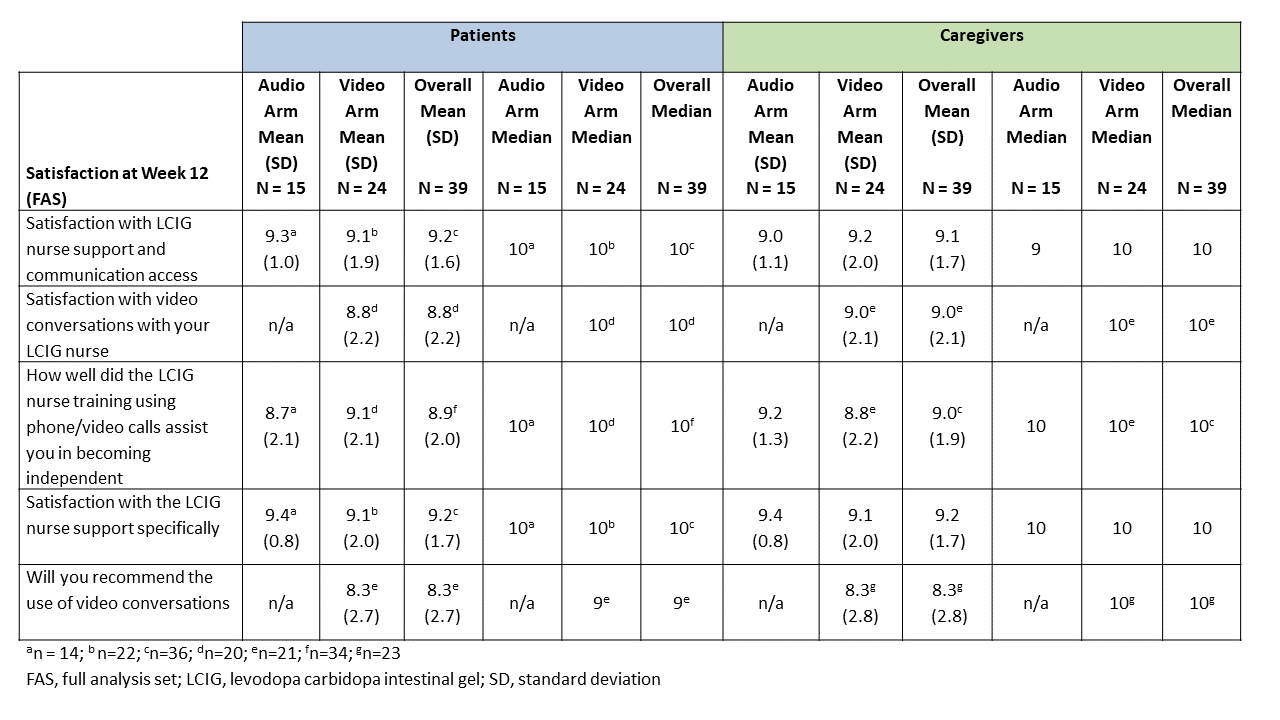Category: Technology
Objective: To evaluate the feasibility and patient satisfaction of video-assisted telenursing as well as demonstrate resolution for treatment-related issues in the real-word levodopa-carbidopa intestinal gel (LCIG) nurse support program.
Background: For LCIG treatment in patients with advanced Parkinson’s disease (aPD), a nurse support program provides education, follow-up, and troubleshooting. Video-assisted telenursing may lead to agile issue resolution and subsequently high patient, caregiver, and physician satisfaction..
Method: This multi-country, nonrandomized, observational study evaluated patient, caregiver, and physician satisfaction of audio and video-assisted telenursing in the LCIG nurse support program in patients with aPD. The primary endpoint of the study was patient acceptance, measured by the patient satisfaction with LCIG nurse support and communications access at week 12 (Visual Analog Scale [VAS] from 1-10). SAEs and AEs leading to study discontinuation were evaluated.
Results: Forty-one patients were enrolled in the study; the full analysis set had 15 patients in the audio arm and 24 patients in the video arm (2 discontinued due to AE and lost to follow-up). In the video arm, mean patient satisfaction VAS scores were 9.1, 8.8, 9.1, and 8.3 for nurse support and communication access (primary endpoint), video conversations, assistance in becoming independent, and recommendation of the use of video calls, respectively [Table 1]. Mean caregiver satisfaction VAS scores were 9.2, 9.0, 8.8, and 8.3 for nurse support and communication access, video conversations, assistance in becoming independent, and recommendation of the use of video calls, respectively. Physician satisfaction scores were aligned with patient and caregiver satisfaction scores. Sixty-five percent of issues were resolved with remote video-based education or troubleshooting. No differences between scores were observed in the audio and video arms. There were no significant differences in the least square means Modified Caregiver Strain Index Score from baseline to week 12 between the audio and video arms (P=0.4). No patients discontinued the study due to treatment-emergent AEs; safety was consistent with the established LCIG safety profile.
Conclusion: Video-assisted telenursing for LCIG therapy led to good patient, caregiver, and physician satisfaction with nurse support.
References: *Note* Used Hoehn & Yahr staging which may appear in Baseline Characteristics Table in poster (if accepted); however, not used in abstract
To cite this abstract in AMA style:
T. Gurevich, A. Evans, G. Kägi, D. Koziorowksi, L. Bergmann, JC. Parra Riaza, O. Sanchez-Soliño, J. Slawek. Patient and caregiver satisfaction of video-assisted telenursing in patients treated with LCIG [abstract]. Mov Disord. 2022; 37 (suppl 2). https://www.mdsabstracts.org/abstract/patient-and-caregiver-satisfaction-of-video-assisted-telenursing-in-patients-treated-with-lcig/. Accessed January 1, 2026.« Back to 2022 International Congress
MDS Abstracts - https://www.mdsabstracts.org/abstract/patient-and-caregiver-satisfaction-of-video-assisted-telenursing-in-patients-treated-with-lcig/

